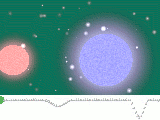
Mercury's moon
Encyclopedia
A moon
orbiting Mercury
was, for a short time, believed to exist.
On March 27, 1974, two days before Mariner 10
made its flyby of Mercury, instruments began registering large amounts of ultraviolet
radiation in the vicinity of Mercury which, according to one astronomer
, "had no right to be there". By the next day, the radiation had disappeared; it reappeared three days later, appearing to originate from an object which was, seemingly, detached from Mercury. Some astronomers speculated that they had detected a star
, but others argued that the object must be a moon, citing the two different directions the radiation had emanated from and the belief that such high-energy radiation
could not penetrate very far through the interstellar medium
. Adding to their arguments, the object's speed was calculated to be 4 kilometers per second (2.4 miles per second), which matched the expected speed of a moon.
 Soon, however, the "moon" was detected moving away from Mercury, and was, eventually, identified as a star, 31 Crateris
Soon, however, the "moon" was detected moving away from Mercury, and was, eventually, identified as a star, 31 Crateris
. The origin of the radiation detected on March 27 is still unknown. 31 Crateris happens to be a spectroscopic binary with a period of 2.9 days, and this may be the source of the ultraviolet radiation.
Mercury's moon, although non-existent, did spark an important discovery in astronomy
: ultraviolet radiation, it was found, was not as completely absorbed by the interstellar medium as was formerly thought.
Natural satellite
A natural satellite or moon is a celestial body that orbits a planet or smaller body, which is called its primary. The two terms are used synonymously for non-artificial satellites of planets, of dwarf planets, and of minor planets....
orbiting Mercury
Mercury (planet)
Mercury is the innermost and smallest planet in the Solar System, orbiting the Sun once every 87.969 Earth days. The orbit of Mercury has the highest eccentricity of all the Solar System planets, and it has the smallest axial tilt. It completes three rotations about its axis for every two orbits...
was, for a short time, believed to exist.
On March 27, 1974, two days before Mariner 10
Mariner 10
Mariner 10 was an American robotic space probe launched by NASA on November 3, 1973, to fly by the planets Mercury and Venus. It was launched approximately two years after Mariner 9 and was the last spacecraft in the Mariner program...
made its flyby of Mercury, instruments began registering large amounts of ultraviolet
Ultraviolet
Ultraviolet light is electromagnetic radiation with a wavelength shorter than that of visible light, but longer than X-rays, in the range 10 nm to 400 nm, and energies from 3 eV to 124 eV...
radiation in the vicinity of Mercury which, according to one astronomer
Astronomer
An astronomer is a scientist who studies celestial bodies such as planets, stars and galaxies.Historically, astronomy was more concerned with the classification and description of phenomena in the sky, while astrophysics attempted to explain these phenomena and the differences between them using...
, "had no right to be there". By the next day, the radiation had disappeared; it reappeared three days later, appearing to originate from an object which was, seemingly, detached from Mercury. Some astronomers speculated that they had detected a star
Star
A star is a massive, luminous sphere of plasma held together by gravity. At the end of its lifetime, a star can also contain a proportion of degenerate matter. The nearest star to Earth is the Sun, which is the source of most of the energy on Earth...
, but others argued that the object must be a moon, citing the two different directions the radiation had emanated from and the belief that such high-energy radiation
Radiation
In physics, radiation is a process in which energetic particles or energetic waves travel through a medium or space. There are two distinct types of radiation; ionizing and non-ionizing...
could not penetrate very far through the interstellar medium
Interstellar medium
In astronomy, the interstellar medium is the matter that exists in the space between the star systems in a galaxy. This matter includes gas in ionic, atomic, and molecular form, dust, and cosmic rays. It fills interstellar space and blends smoothly into the surrounding intergalactic space...
. Adding to their arguments, the object's speed was calculated to be 4 kilometers per second (2.4 miles per second), which matched the expected speed of a moon.
Binary star?

Crater (constellation)
Crater is a constellation. Its name is Latin for cup, and in Greek mythology it is identified with the cup of the god Apollo. It was one of the 48 constellations listed by the 2nd century astronomer Ptolemy, and remains one of the 88 modern constellations...
. The origin of the radiation detected on March 27 is still unknown. 31 Crateris happens to be a spectroscopic binary with a period of 2.9 days, and this may be the source of the ultraviolet radiation.
Mercury's moon, although non-existent, did spark an important discovery in astronomy
Astronomy
Astronomy is a natural science that deals with the study of celestial objects and phenomena that originate outside the atmosphere of Earth...
: ultraviolet radiation, it was found, was not as completely absorbed by the interstellar medium as was formerly thought.
See also
- List of hypothetical astronomical objects
- Earth's second moon

